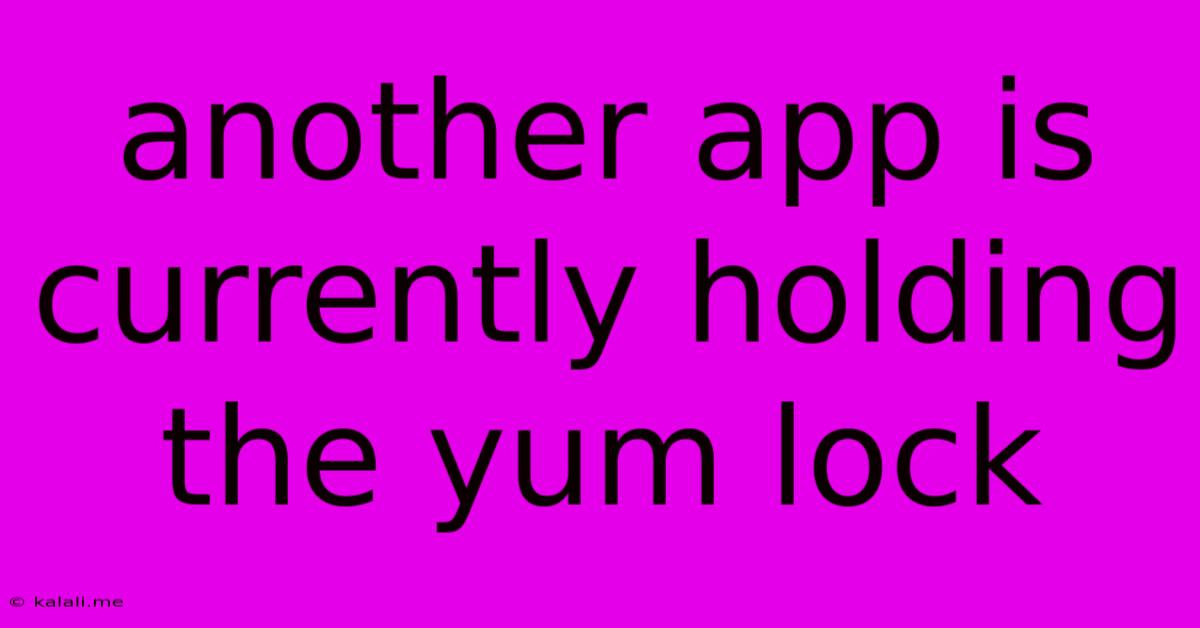Another App Is Currently Holding The Yum Lock
Kalali
Jun 09, 2025 · 3 min read

Table of Contents
Another App is Currently Holding the Yum Lock: Troubleshooting and Solutions
The dreaded "Another app is currently holding the yum lock" error message in Linux can bring your system updates to a screeching halt. This frustrating issue prevents you from using the Yellowdog Updater, Modified (YUM), a crucial package manager for many distributions like CentOS, Fedora, and RHEL. This article will delve into the causes of this problem and provide practical solutions to regain control of your system updates. We'll explore various troubleshooting steps, ranging from simple commands to more advanced techniques, ensuring you can get back to updating your system swiftly and efficiently.
Understanding the Yum Lock
YUM uses a lock file to prevent multiple processes from simultaneously modifying the system's package list and repositories. This lock mechanism ensures data integrity and avoids conflicts during package installations or updates. When you encounter the "Another app is currently holding the yum lock" error, it means another process—be it a previous YUM command, a different package manager, or even a rogue script—is still accessing or modifying the system's package configuration files. This prevents new YUM operations from starting.
Common Causes of the Yum Lock
Several factors can contribute to the yum lock issue. Here are some of the most prevalent causes:
- Incomplete or Aborted YUM Operations: A previous YUM command that was interrupted (e.g., due to a power outage or network failure) can leave the lock file intact, blocking subsequent commands.
- Conflicting Package Managers: Running other package managers concurrently with YUM, such as DNF (Dandified YUM) or RPM (Red Hat Package Manager), can lead to lock conflicts.
- Faulty Scripts or Processes: Malfunctioning scripts or background processes that interact with package management might inadvertently hold the lock.
- System Errors: Underlying system issues can sometimes prevent the lock file from being released properly.
Troubleshooting and Solutions
Let's explore several methods to resolve the "Another app is currently holding the yum lock" problem:
1. Identifying the Locking Process:
This is the first crucial step. Using the lsof command, you can pinpoint the process holding the lock:
lsof | grep yum
This command will display any processes currently accessing files related to YUM. If a process is identified, you'll need to determine its PID (Process ID).
2. Terminating the Locking Process (Use with Caution):
Once you have the PID of the locking process, you can attempt to terminate it using the kill command. However, proceed with caution: terminating the wrong process can destabilize your system.
kill
Replace <PID> with the actual Process ID. If a single kill command isn't enough, you may try kill -9 <PID>, but this is a forceful termination and should be used as a last resort.
3. Removing the Lock File (Use with Extreme Caution):
This method should only be used if the previous steps fail. Incorrectly removing the lock file can corrupt your system's package database.
Locate the lock file (usually /var/run/yum.pid or similar). Use the rm command to remove it:
sudo rm /var/run/yum.pid
Remember to replace /var/run/yum.pid with the actual path if it's different. After removing the lock file, try running your YUM command again.
4. Rebooting Your System:
If all else fails, rebooting your system will often clear the lock and allow YUM to function normally. This is a simple yet effective solution in many cases.
5. Checking for Package Manager Conflicts:
Ensure you aren't running multiple package managers concurrently. Stick to using YUM (or its modern equivalent, DNF) for package management to avoid conflicts.
Preventing Future Yum Lock Issues:
- Avoid Interrupting YUM Operations: Let YUM commands complete without interruptions.
- Properly Handle Package Management: Use only one package manager at a time.
- Regular System Maintenance: Keep your system updated and free from unnecessary processes.
By following these troubleshooting steps, you should be able to resolve the "Another app is currently holding the yum lock" error and resume your system updates. Remember to always proceed with caution when terminating processes or deleting files. If you're unsure about any step, consider seeking assistance from experienced Linux users or your system administrator.
Latest Posts
Latest Posts
-
Did Perry Mason Ever Lose A Case
Jun 09, 2025
-
All Shower In The House No Cold Water
Jun 09, 2025
-
Where Should Water Hammer Arrestors Be Installed
Jun 09, 2025
-
How To Hook Up A Gas Range
Jun 09, 2025
-
Error When Starting Dev Server Referenceerror Structuredclone Is Not Defined
Jun 09, 2025
Related Post
Thank you for visiting our website which covers about Another App Is Currently Holding The Yum Lock . We hope the information provided has been useful to you. Feel free to contact us if you have any questions or need further assistance. See you next time and don't miss to bookmark.